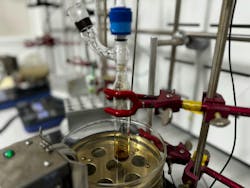One-Pot Process Converts Aromatic Ketones to Aromatic Esters
In what they are hailing as a world first, researchers in Japan have developed a one-pot process to convert aromatic ketones into aromatic esters.
While aromatic ketones are important industrially, their use is limited by the complex and costly procedures relying on directing groups and transition metals needed to break their strong carbon bonds.
Led by professor Junichiro Yamaguchi from the Faculty of Science and Engineering, School of Advanced Science and Engineering at Waseda University, Tokyo, Japan, the researchers have combined a Claisen and a retro-Claisen reaction in the same step. The first combines two molecules to form a larger intermediate compound, while the second modifies this to produce the desired ester.
The method is highly flexible, allowing it to work with reactants, including alcohols, phenols, amines and thiols. It also enables seven different types of chemical transformations, producing chemicals such as thioethers, aryl groups, hydrogen, amines and ethers.
The catalyst shows the stability and reusability needed in industrial applications.
"This reaction represents the first successful example of directly catalyzing aromatic ketones without the use of directing groups, setting the stage for future advancements in synthetic chemistry,” explains Yamaguchi.
The research, published in Chem Sept. 12, 2024, highlights its potential for broader use in synthetic chemistry.
Yamaguchi currently has no plans to scale up the new process, although he believes the one-pot method makes this possible. One challenge, however, is to find a way to deal with the significant number of byproducts created during the reaction.
On the other hand, he points out that the simple conditions required for the Claisen/Retro-Claisen reaction means that it has garnered considerable academic interest.
Yamaguchi and his team are now applying the same reaction methodology to aromatic ketones with heteroaromatic rings. “I can't go into the detailed conditions yet, but since this reaction allows for the conversion of an aromatic ring into various heteroaromatic rings in a single step, I think it could be useful in fields such as medicinal chemistry,” he noted.
Overall, he believes the one-pot approach is a significant leap forward in synthetic chemistry, offering a more streamlined, cost-effective and multifaceted method for utilizing aromatic ketones. As the method is refined, it promises to play a crucial role in advancing the field of synthetic chemistry and beyond, Yamaguchi believes.




